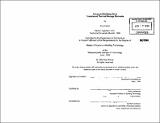Advanced building skins : translucent thermal storage elements
Author(s)
Kienzl, Nico, 1971-
DownloadFull printable version (23.41Mb)
Alternative title
Translucent thermal storage elements
Other Contributors
Massachusetts Institute of Technology. Dept. of Architecture.
Advisor
Chris Luebkeman.
Terms of use
Metadata
Show full item recordAbstract
Advances in the material sciences continue to provide designers with a wealth of new materials that challenge preconceived notions of the building envelope and its performance. These new technologies can be used to create new adaptable building skins and allow for an active interaction with the environment to reduce energy consumption in buildings. This thesis investigates the function of the building enclosure in relation to these new material developments and recent changes in the treatment of the building envelope. New glazing, insulation and thermal storage technologies are discussed in the context of their technical trajectories. Based on th is discussion of functions and technologies, a specific set of materials is selected and their combination into a facade panel is proposed. Th is new element is a layered facade component including electrochromic glazing, aerogel and a phase change material. The combination is analyzed for its potential as a translucent thermal storage wall in the context of American residential construction. Aspects of performance, integration and design are explored through calculations, experimental testing and the creation of scaled models and a prototype element. For this purpose an environmental test chamber has been built on MIT's campus to evaluate the performance of new facade elements. The result of this study shows the potential for such innovative facade concepts and points towards areas of future research to make such concepts technically and economically feasible. In particular, the need for better tools to evaluate the performance of such advanced skins is identified in order to achieve successful implementation of these new technologies and ideas.
Description
Thesis (S.M.)--Massachusetts Institute of Technology, Dept. of Architecture, 1999. Includes bibliographical references (leaves 127-131).
Date issued
1999Department
Massachusetts Institute of Technology. Department of ArchitecturePublisher
Massachusetts Institute of Technology
Keywords
Architecture.